Mr Brainwash Is Ready To Make His Mark On LA
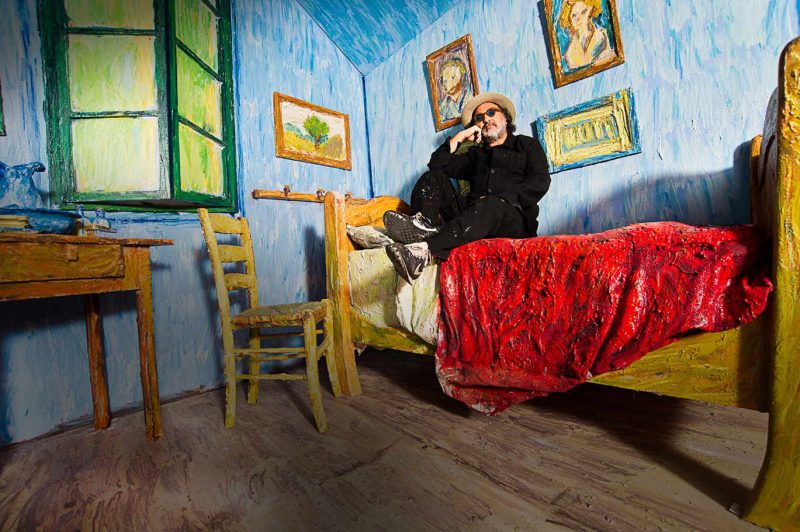 Photo Credit: Andreas Branch
Photo Credit: Andreas Branch
Thierry Guetta has a new lease on life and an even bigger desire to create a legacy. This is how he’s planning on doing both.
BY LAURA SCHREFFLER
PHOTOGRAPHY ANDREAS BRANCH
GROOMING JUANITA LOPEZ
 Photo Credit: Andreas Branch
Photo Credit: Andreas Branch
CALL IT WHAT YOU WANT — be it an epiphany, a life review, or a wake-up call — but last year, Thierry Guetta had it. The artist most commonly known as Mr Brainwash had one hell of a near-death experience, his life literally flashing before his eyes (which is also when he decided to open a museum in his own honor, but more on that later.)
Guetta, now 57, started having headaches last year and chalked it up to side effects of the COVID-19 vaccine. But it wasn’t until he blacked out while attending a wedding in Mexico that he truly realized something was wrong.
“I called [my team] in LA and I said, ‘There is a problem in my head. You need to get me someone, anyone, [to see if something is wrong],’” he recalls.
Upon arriving in Los Angeles, a CT scan showed there was, indeed, a problem — a big one, at that: blood in his brain.
“So now I’m like, What the fuck? Brainwash has a problem with his brain,” the French street artist recounts mournfully.
At Cedars-Sinai hospital, he was told that he had to have an extremely delicate operation: one that involved putting a tube in his head and closing off a vein. It was overwhelming, especially for a man who has made it his life’s mission to live every day with joy and zest.
“I’m thinking, It’s done,” he admits, sharing that he went to several more doctors in search of second and third opinions. The headaches got worse. Finally, he found a specialist who told him something incredibly frightening: “He said, ‘There are three things that could happen. One, that everything goes away. The second is that you could become handicapped. And the third thing is that you die.’ That’s it. So imagine that you get this answer. This is your life. How do you get up, walk out of the doctor’s office? My mind started to race. All I could think was how life is important, how life is beautiful. And did I do enough good in my life?”
When he finally went for the operation, his surgeon deemed that closing off the vein in his head would result in a 50-50 chance of blindness, so they went in through his spine. It was, quite understandably, terrifying.
“Just imagine that you’re in the hospital. With [COVID] in the mix, nobody can come up with you. So you have your kids that are downstairs and you say goodbye, but you don’t know if you are going to say goodbye forever. You hug them, and you start crying when you go into the elevator, all alone.”
But in he went, and despite some additional complications, two days later, the operation finally took place. But, needless to say given that I’m speaking to him today, this particular story had a happy ending. “At the end of it, everything was fixed. One moment I almost gave up, but the way that my personality is, I went and got better. I told myself, I’m going to be fine.”
But before going in for surgery, he had another, deeper conversation with himself. “[I told myself that] I wasn’t finished. I have so many more things that I want to do.” And so, when he woke up, his joie de vivre returned — in the biggest and best way possible. “I told myself, This is the beginning.”
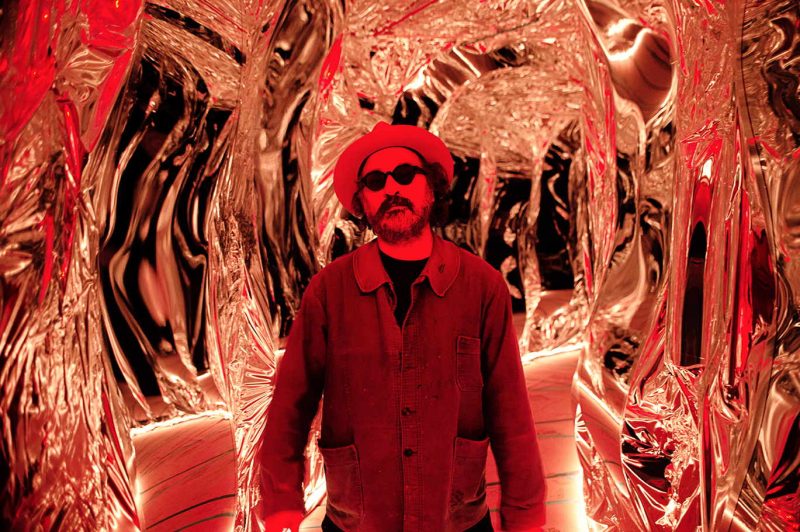 Photo Credit: Andreas Branch
Photo Credit: Andreas Branch
What he meant is that it was the beginning of his second chapter, his new lease on life. And as such, he was determined to see a project he had started before the pandemic come to fruition — the one and only Mr Brainwash Art Museum.
Guetta had initially found and leased a prime location at 465 N. Beverly Drive in Beverly Hills prior to the coronavirus quarantine, and as such, was the only person to see its potential. (The former building for The Paley Center for Media, which was designed by Getty Center architect Richard Meier in 1996, previously housed spaces such as the Aaron Spelling Reception Area and the Garry Marshall Pool.)
He thought the project might never come to fruition, but he decided to build it anyway — especially after cheating death. “I decided I’m going to show this here, and what’s more, I’m going to make it alive,” he declares, sharing, “The museum is the beginning of my next decade. It’s going to be something else. I’m going to go far.”
The museum truly signifies that, for the first time in a long time, Guetta is doing something purely for himself. The Mr Brainwash Art Museum — where we are currently sitting, alone in the museum’s theater surrounded by typewriters, a huge painting of Steven Spielberg with film coming out of a cannister, and life-sized replicas of Homer and Lisa Simpson — is the result of his blood, sweat, and tears, sure, but also his personal journey — a journey marked by highlights such as the 2010 Banksy-directed documentary Exit Through the Gift Shop; his self-financed debut exhibit Life Is Beautiful, where his work sold for five-figure sums; and his design of both Madonna’s 2009 Celebration album cover and Michael Jackson’s posthumous 2014 release, Xscape.
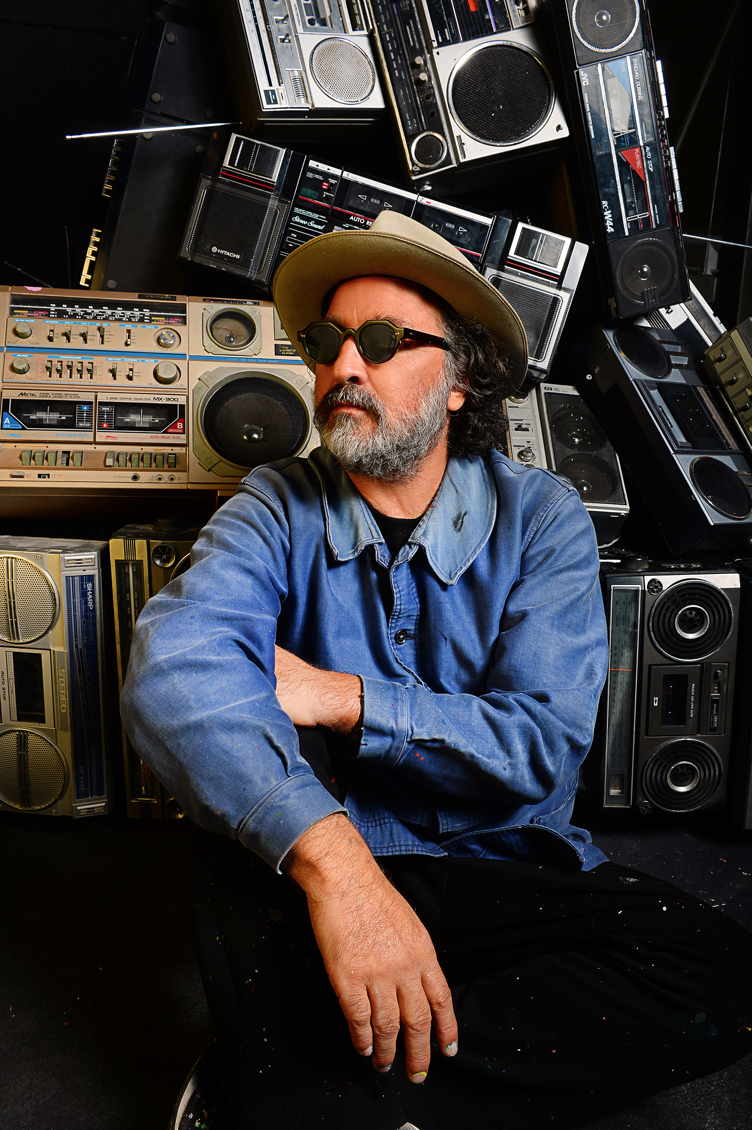 Photo Credit: Andreas Branch
Photo Credit: Andreas Branch
“This is a moment in my life that I have been working towards for many, many years,” he says now. “I mean, I always make art, but on the side, I’ve always done something else that I’ve never shown. It’s been almost 13 years now that I’ve been doing this, doing other things. Now, I’m doing this for me, because after 12 years, it’s time. I’ve waited to do something for myself, and this [museum] is more of what I want to do. It’s a little reward just for me.”
Not that he doesn’t like or appreciate what he’s done or been commissioned to do in the past. But this is different. It is special, and specific. “I like what I’ve done in the past, too, but there is something more artistic in doing this, something that blows my mind,” he hastens to add.
So when The Paley Center for Media announced it was moving to the Beverly Hills Public Library, Guetta saw his window of opportunity. “In my world, the impossible has the word ‘possible,’ and so I fought for seven months to get that space. And the moment I got it, I was so happy that I started to work to make it happen right away. And months later, [COVID] came in. So this has been sitting empty. For two years, I completely abandoned it; I worked on different things. And a few months ago, I came back and started to put it back together, because after [I’m done here], this building is going to get torn down. It’s not going to exist anymore.”This is common with Guetta’s shows, though he swears he doesn’t choose the locations intentionally to be “the last” or to leave his mark — fate always intervenes to make it so. And although it isn’t his plan, he’s certainly not complaining. When I press him on why he thinks his takeovers of soon-to-be-destroyed spaces inevitably occur, his answer is this: “It feels like history, you know? I’m locked in history. I’m part of the architecture and the building itself in Beverly Hills that is not going to exist after me.”
And with this history of being Mr Brainwash, there is, indeed, a story he wishes to tell. With this three-story museum that will feature his monumental paintings and sculptures, immersive installations, and the previously mentioned 150-seat movie theater, he hopes to rewrite media history, to “brainwash” our minds to see familiar characters behaving in unexpected ways.
“The story I want to tell is just happiness,” he says. “I like to bring joy to people and to bring them happiness, too. I have love for all. My whole thing is What can I do to make people happier? What can I do to make everything more fun? That’s my art on another level —and also, me.”
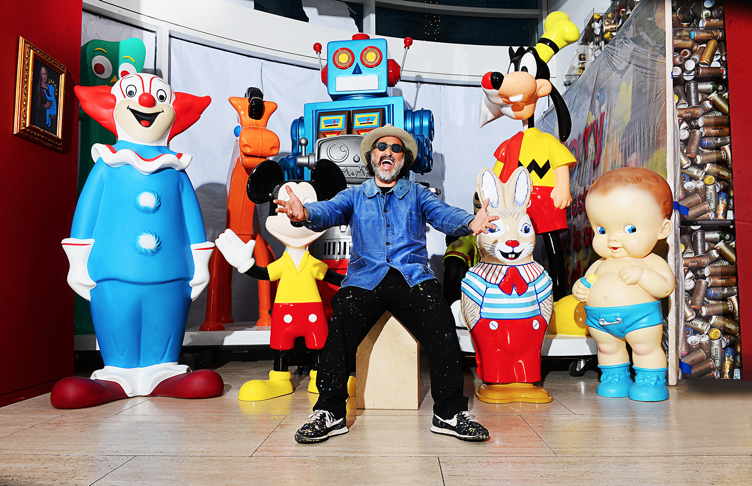 Photo Credit: Andreas Branch
Photo Credit: Andreas Branch
IT IS AN ABSOLUTELY MISERABLE DAY IN LA. It’s pouring, in fact, and the sound of rain is getting louder and louder inside of the museum — so much so, in fact, that water starts leaking from the ceiling. But it’s fine. Mr Brainwash is optimistic, vaping away, smiling, hamming, virtually dancing around the space, followed by his ever-present cameramen, who literally document every moment of his life. (He says that if he dies, he would have wanted every moment captured, and in light of what he just went through, I get it.) Nothing gets him down for long. And also, he has an entire month to go until the museum actually opens on December 11. There’s plenty of time to perfect it. Trust him: After all, he’s the guy who almost ran out of it (time, that is).
Previously, Guetta had taken me on a tour of said museum, proudly, methodically. It is a hyper-visual explosion that remixes historical imagery, pop culture icons, and masters of the arts: an orchestrated collision of pop and classical, reminiscent of his street art beginnings.
In this space is his homage to the fallen greats of California — Kobe Bryant, Steve Jobs, Tupac Shakur — all surrounded by the heavenly white tools of their trades. There is a room dedicated to Vincent van Gogh, a frequent fixture in his art; a life-sized replica of LeBron James; a gigantic Matchbox car priced at $1.95; books, books, and more books (some of which we open and discover that they are actually treasures from the early 20th century); a nod to Exit Through the Giftshop; a gallery, where his paintings and other paraphernalia will be for sale; and, on the rooftop with its 360-degree views of Beverly Hills (currently a bit bleak because of the storm), a window with “Let Them Eat Crack” in graffiti, and another emblazoned with “U.S. Bank(sy).”
The latter has always been a name closely associated with Mr Brainwash, and not just because the infamous and unknown street artist directed a film about Guetta’s rise to fame. Many believe Mr Brainwash is Banksy, a claim that he will never refute.
His voice a sing-song, he says, “Am I Banksy? I don’t know. Because when I say ‘no,’ you say ‘yes.’ When I say ‘yes,’ you say ‘no.’ [For the record, he has never said ‘yes.’] So, at the end, time will tell. [But yes] I for sure know who Banksy really is.”
Banksy or not, public opinion is wildly rampant when it comes to Mr Brainwash and is something Guetta personally has struggled with in the past. But no more: Now, he’s living freely. He doesn’t need to be liked or admired, confined or defined by public perception.
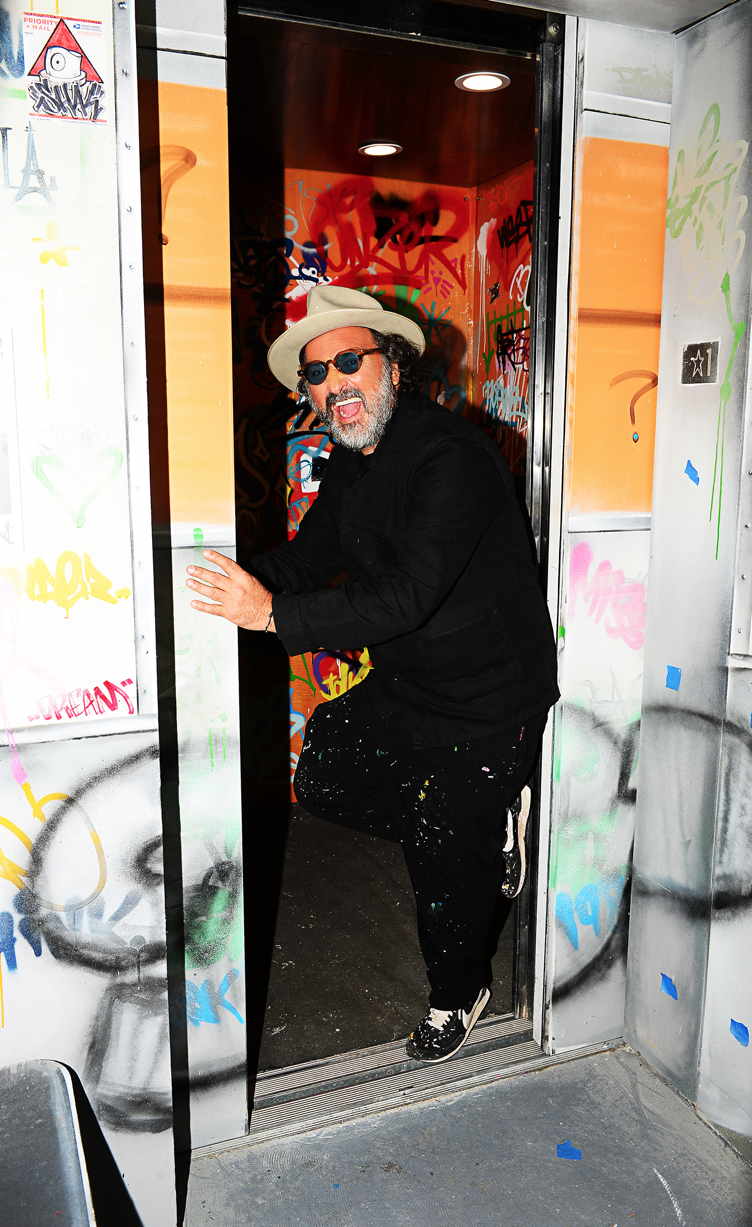 Photo Credit: Andreas Branch
Photo Credit: Andreas Branch
“People think they know me, but they don’t,” he declares. “I get judged by people from what they see in a three-minute interview. People have the freedom of deciding whatever they want, anything they choose. And there are a lot of things in my life that I’m silent on — what I like, what I want. But that’s the way the world works, you know?”
He pauses, before sharing that he does want the world to know him — or know as much of him as he’ll allow, rather — the true Thierry Guetta, the true Mr Brainwash. “This museum is a little bit about who I am, and how I never gave up. [Most of what I did in the past was because I had] something I wanted to prove, that I could go beyond what was asked of me, do it big, and make it to another level, [to show that there’s] never been another person like me to do something as crazy as I’ve done.”
Don’t misunderstand: Just because he’s finally doing something for himself doesn’t mean that Guetta is going to give up on his commercialized projects, like when he created an installation for the opening of Hublot’s Bal Harbour Shops boutique during Miami Art Week, when he created art based on the iconic jewelry of Harry Winston at the brand’s Rodeo Drive boutique, or when he collaborated with Mercedes-Benz by painting several cars during their Evolution Tour. But at least now, he’ll always know that he created something special — something that no one can ever take away from him. At the end of day, how many living artists have their very own museum (even one that will one day be torn down)?
“It doesn’t happen,” he says proudly. “It doesn’t exist! But I always break walls. I change walls. And this is a museum that is going to be alive. I can come back here in the night and change a few things, add a few things. The room you see today might be different from the room you see tomorrow. It’s going to be a museum that travels — hopefully to Miami, New York, and Toronto to start — and it will be open at night because I’m going to do a lot of things with a projection so that people can and will want to come here after dinner. I want to change history, and do things differently than what has been done for the past 100 years.”
I tell him he’s ambitious, and he nods and thoughtfully strokes his salt-and-pepper beard. “I’m never satisfied, you know,” he admits. “I always want to do more. And I know that this will be alive for a little while, and then it will disappear … but then it will go somewhere else and be alive somewhere else. The story will continue.”
In the meantime, the real story is inside these eclectic and vibrant walls. Every piece of art here tells the story of the evolution of Thierry Guetta, used-clothing-store proprietor and amateur videographer, to Mr Brainwash, world-renowned street artist and pop culture icon.
 Photo Credit: Andreas Branch
Photo Credit: Andreas Branch
The one takeaway for others from the museum, in his opinion, is that no matter what your personal dream is, you should work your hardest until it comes true, like he did here. “[I want to share that] people should believe in themselves, and really do what they want in life. It doesn’t matter what you do, but you should do it well, and do it with your heart, because at the end of the day, everyone is an artist. A janitor, he’s an artist, the way he holds his broom — that’s art. A businessman, a computer guy — we are all artists. But it’s very important to be real, because being a real artist is not just about what you do, but who you are.”
He references van Gogh, a personal hero, saying, “He painted all his life, but he never sold one painting, and he killed himself. But how is it that after all this, this man is in every museum in the world and nobody can afford his paintings? How? Time tells about who he is: his life, his truth, that he was passionate about something he loved.”
And that is Mr Brainwash to a “T,” and for that matter, Thierry Guetta too. Passion, energy, vibrancy — they are all in there in every mannerism, every expression. Because to Guetta, life has always been beautiful. It is his signature phrase, yes, but also his first show, his emblematic art, his very way of being.
“I never get tired of saying ‘life is beautiful.’ I never get tired of writing it. I have written it almost every day of my life,” he admits. “When you accept that, your life will change. Take today, for example. We are here in Los Angeles, and it’s raining. The only thing I think of when I hear the rain is I’m happy. But others who hear the rain will complain, but if we didn’t know bad, we wouldn’t know what good is.”
I goggle at him for a moment, openly. He is right. (And I had been about to complain about the rain. Is he psychic?)
Maybe not, because he doesn’t know — and he readily admits that he has no idea what the future holds — and that’s OK. He wasn’t ready for the end last year, and he isn’t ready for it now, but when that day does come, he knows that he will have zero regrets.
“I don’t know everything but I do know this,” he begins. “We are here today. Life, for me, is one day at a time. Live today and worry tomorrow. People always tell me that life is too short. And for me, life is very long, because every day is a new life. So imagine this: I live 365 new days a year. I’m 57. Do you know how many lives that is? It’s a lot, and I’m still going to live a little bit longer. But it’s important to remember that every day can be different. Every moment you go out, something can happen. So you don’t know what tomorrow will bring. The only thing you know in life is that you’re living it.”
He smiles — at the empty theater beyond, at the painting of Spielberg, at the Simpsons, at me — a big, goofy, quintessentially Mr Brainwash smile; a Thierry Guetta smile. And he says, “What I’ve learned in life is to be thankful for everything; to be grateful for your life, to be grateful for what you do, and for who you are. I know you can have more, know you can do more, but [you should] be content with what your life is. Because the true gold and the true diamond is inside of you, and it’s your health. The rest of it, it’s nothing. Money doesn’t buy health. You cannot be a billionaire and say, ‘Oh, I want to buy my sickness to be fixed.’ It’s not going to happen. So enjoy your life every day. Try to do something that you love. Try to see the positive side of everything. Remember that life is beautiful, and beauty is all around you.”
Here is his proof — not that he needs it.
 Photo Credit: Andreas Branch
Photo Credit: Andreas Branch













